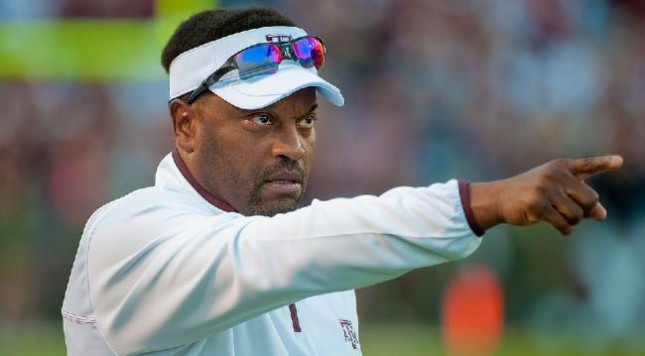Alabama is Alabama. Nick Saban’s the coach, fer cryin’ out loud. The Crimson Tide might not drown everyone else in the SEC West, but they’re not likely to be particularly mediocre anytime soon.
Auburn has Gus Malzahn, one of the brightest head coaches in the country, and a track record of being a major national factor once every few years over the past third of a century in college football. Perhaps not relevant on an unceasingly annual basis, Auburn is certainly a program which makes its presence felt at some point in a three- or four-year increment. The Tigers never go too long without fielding a particularly strong team.
Arkansas might not put all the pieces together this season under Bret Bielema, but the Razorbacks do appear to be rising — perhaps not meteorically, but steadily at the very least.
Mississippi State watched a lot of things break in the right direction last season. Now, the Bulldogs lose a lot of starters from their history-making 2014 squad. They should very clearly be worse.
LSU is a portrait of uncertainty, true, but the Tigers’ fears and longings so fully reside in one position: quarterback. It’s been that way for awhile now in Baton Rouge, so even while no one knows how the Bayou Bengals will react to this season, their uncertainties can be pinpointed a little more precisely.
We haven’t even mentioned the chaotic SEC East, either.
*
What does that long prelude serve to convey? It is only this: With the sole exception of Ole Miss, no team in the SEC embodies the league’s uncertain position heading into 2015 more than the Texas A&M Aggies. If some teams can be relied on to get better (Arkansas); other teams can be depended on to maintain their standing in the league (Bama); and still other teams can safely be picked to regress (Mississippi State), a truckload of SEC teams stand on very shaky ground. It is as though the huge earthquake predicted to hit Seattle in the next 50 years has already hit the SEC, and most schools in the conference stand on land that’s highly liquefied underneath.
As mentioned above, some of those schools in the SEC’s large “uncertain” basket are unsure of their prospects because of longstanding deficiencies at one or two positions. For LSU and also for Florida and Tennessee, that position has been quarterback. For other programs, though, difficulties can’t be attached to just one or two areas, and entering 2015, Texas A&M seems to fit that profile better than any other league school outside of Oxford, Mississippi.
The Aggies’ demolition of South Carolina in the 2014 season opener seemed to suggest that a huge year lay ahead for Kevin Sumlin. Yet, in the fullness of time, the nation realized that South Carolina just wasn’t very good; A&M’s Thursday night opener became a resoundingly negative verdict on the Gamecocks, as opposed to a hugely positive revelation about the Aggies.
The rest of the SEC season played out accordingly.
Texas A&M, against teams with some semblance of a pass rush, couldn’t throw.
The Aggies, against teams with superior line play, were pushed around and bullied into submission.
Sumlin’s passing game, against opponents with alert and agile cornerbacks, did not do whatever it wanted.
All in all, the South Carolina opener sent so many misleading signals about the actual quality of the Aggies. Over the next three months of the 2014 season, A&M lacked a dominant quarterback who could rescue the team the way Johnny Manziel did when other facets of the team were not in working order. The defense that showed up (or rather, failed to do so) in the 2013 Chick-Fil-A Bowl against Duke bore a striking resemblance to the defense which existed throughout the 2014 campaign. The Aggies therefore plucked John Chavis from LSU and secured the SEC veteran as their new defensive coordinator.
The obvious hope is that the arrival of Chavis will bear fruit in 2015, but the underlying reality surrounding this program is that the large number of positional deficiencies means a quick fix should not be expected.
When a problem can be pinpointed and linked to only one or two spots on a roster, improvement is exponentially more attainable. That’s not the case for A&M. Therefore, after a 2014 season in which the SEC clearly regressed relative to 2013, the Aggies are hoping that if their conference improves, the central source of that great leap forward will come from College Station.
It only makes sense, too: With Alabama and Auburn being expected to be the top two teams in the SEC West, and with Mississippi State being tabbed by almost everyone as a sure-thing regression candidate, the way Texas A&M performs might determine just how deep and formidable the SEC West turns out to be. In 2015, there is no more fascinating team in that division — and by extension, the SEC itself — than the Aggies.

